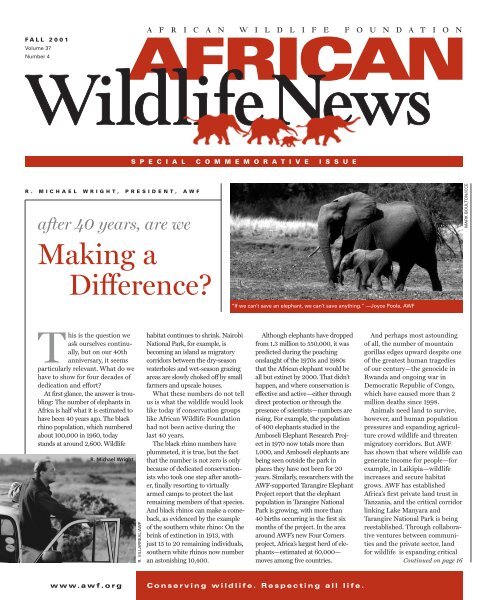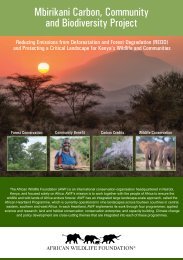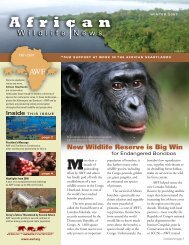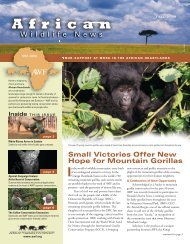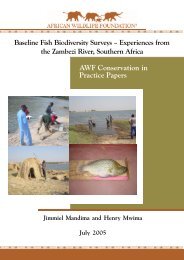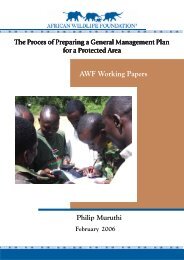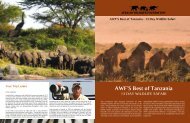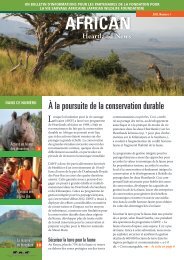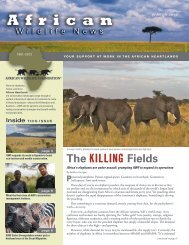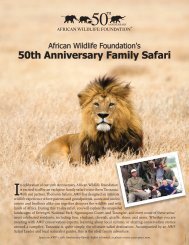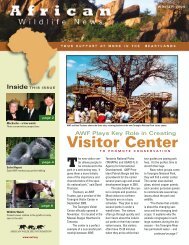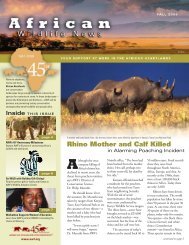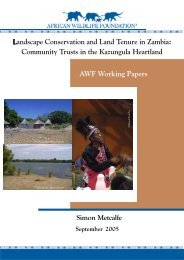Making a Difference? - African Wildlife Foundation
Making a Difference? - African Wildlife Foundation
Making a Difference? - African Wildlife Foundation
You also want an ePaper? Increase the reach of your titles
YUMPU automatically turns print PDFs into web optimized ePapers that Google loves.
F ALL 2001Volume 37Number 4A F R I C A N W I L D L I F E F O U N D A T I O NS P E C I A L C O M M E M O R A T I V E I S S U ER. MICHAEL WRIGHT, PRESIDENT, AWFafter 40 years, are weMARK BOULTON/ICCE<strong>Making</strong> a<strong>Difference</strong>?“If we can’t save an elephant, we can’t save anything.” —Joyce Poole, AWFThis is the question weask ourselves continually,but on our 40thanniversary, it seemsparticularly relevant. What do wehave to show for four decades ofdedication and effort?At first glance, the answer is troubling:The number of elephants inAfrica is half what it is estimated tohave been 40 years ago. The blackrhino population, which numberedabout 100,000 in 1960, todaystands at around 2,600. <strong>Wildlife</strong>R. Michael WrightR. VILLARREAL/AWFhabitat continues to shrink. NairobiNational Park, for example, isbecoming an island as migratorycorridors between the dry-seasonwaterholes and wet-season grazingareas are slowly choked off by smallfarmers and upscale houses.What these numbers do not tellus is what the wildlife would looklike today if conservation groupslike <strong>African</strong> <strong>Wildlife</strong> <strong>Foundation</strong>had not been active during thelast 40 years.The black rhino numbers haveplummeted, it is true, but the factthat the number is not zero is onlybecause of dedicated conservationistswho took one step after another,finally resorting to virtuallyarmed camps to protect the lastremaining members of that species.And black rhinos can make a comeback,as evidenced by the exampleof the southern white rhino: On thebrink of extinction in 1913, withjust 15 to 20 remaining individuals,southern white rhinos now numberan astonishing 10,400.Although elephants have droppedfrom 1.3 million to 550,000, it waspredicted during the poachingonslaught of the 1970s and 1980sthat the <strong>African</strong> elephant would beall but extinct by 2000. That didn’thappen, and where conservation iseffective and active—either throughdirect protection or through thepresence of scientists—numbers arerising. For example, the populationof 400 elephants studied in theAmboseli Elephant Research Projectin 1970 now totals more than1,000, and Amboseli elephants arebeing seen outside the park inplaces they have not been for 20years. Similarly, researchers with theAWF-supported Tarangire ElephantProject report that the elephantpopulation in Tarangire NationalPark is growing, with more than40 births occurring in the first sixmonths of the project. In the areaaround AWF’s new Four Cornersproject, Africa’s largest herd of elephants—estimatedat 60,000—moves among five countries.And perhaps most astoundingof all, the number of mountaingorillas edges upward despite oneof the greatest human tragediesof our century—the genocide inRwanda and ongoing war inDemocratic Republic of Congo,which have caused more than 2million deaths since 1998.Animals need land to survive,however, and human populationpressures and expanding agriculturecrowd wildlife and threatenmigratory corridors. But AWFhas shown that where wildlife cangenerate income for people—forexample, in Laikipia—wildlifeincreases and secure habitatgrows. AWF has establishedAfrica’s first private land trust inTanzania, and the critical corridorlinking Lake Manyara andTarangire National Park is beingreestablished. Through collaborativeventures between communitiesand the private sector, landfor wildlife is expanding criticalContinued on page 16www.awf.orgConserving wildlife. Respecting all life.
<strong>African</strong> <strong>Wildlife</strong> NewsBOARD OF TRUSTEESStuart T. Saunders, Jr.CHAIRWilliam P. Richards, Jr.VICE CHAIRR. Michael WrightPRESIDENTVictoria LeslieSECRETARYDouglas C. WalkerTREASURERGeorge R. Bunn, Jr.David ChallinorJoan DonnerDale F. DornJudson C. GreenLeila S. GreenJohn H. HeminwayJennifer E. InskeepWilliam E. JamesDennis J. KellerRobin LloydHenry P. McIntosh IVAnne B. MizeEleanor G. NalleJohn H. NorrisJacqueline S. RussellPaul A. SchosbergJeffrey R. Short, Jr.Kelly J. StewartBarry R. SullivanMatthew WeirGordon WilsonTRUSTEES EMERITIArthur W. ArundelE.U. Curtis BohlenGeorge C. HixonRichard M. JacksonSally PingreeRussell E. TrainAFRICAN WILDLIFEFOUNDATIONR. Michael Wright, WashingtonPRESIDENTPatrick J. Bergin, NairobiVICE PRESIDENT FORAFRICAN OPERATIONSAFRICAN WILDLIFE NEWSSharon K. CongdonEDITORStefannie BernsteinASSOCIATE EDITORThe Magazine GroupDESIGN AND PRODUCTION<strong>African</strong> <strong>Wildlife</strong> News is published inWashington, D.C., U.S.A.,four times a year.©2001 by the<strong>African</strong> <strong>Wildlife</strong> <strong>Foundation</strong>1400 16th Street, N.W., Suite 120Washington, DC 20036(202) 939-3333fax (202) 939-3332E-mail: africanwildlife@awf.orgWeb site: www.awf.orgPrinted on Recycled PaperConserving <strong>Wildlife</strong> in Africa:AWF’s 40-Year History1960shelp protect for future generationsThe founders of the <strong>African</strong><strong>Wildlife</strong> Leadership <strong>Foundation</strong>,later the <strong>African</strong> <strong>Wildlife</strong> <strong>Foundation</strong>,had a simple objective: tothe magnificent wildlife heritage ofAfrica that they had experiencedand enjoyed firsthand.Russell Train, Nick Arundel,Jim Bugg, Kermit Roosevelt andMaurice Stans were members ofthe Washington Safari Club’s ConservationCommittee who had allsavored the joys of an <strong>African</strong>safari. “We met to discuss thematter in my chambers as a judgeof the United States Tax Court inWashington, D.C.,” rememberedTrain. “It did not take us long toagree that the fundamental needwas to help develop among<strong>African</strong>s the skill and knowledgethat would equip them to managetheir own wildlife resources.”The group’s timing was fortuitous:As colonial governmentswere giving way to newly independent<strong>African</strong> nations, the needfor professional park and wildlifemanagers was apparent. Colonialpark and game departments traditionallyhad been headed by amateurs,often retired army officerswho loved nature and its wildlife.“We were careful not to define theneed too narrowly,” according toTrain. “It could embrace degreetraining at both the graduate andundergraduate level, nondegreetraining and practical field experience.Training was a niche that noone else was filling, and it wasvitally important.”AWLF’s founders were convincedthat wildlife in Africa representeda renewable naturalresource that could produce substantialrevenue in countries withhard-pressed economies. They sawAWLF as a self-help program thatacknowledged that the future ofAfrica’s wildlife resources was inthe hands of <strong>African</strong>s themselves.AWLF’s role would be to contributeby supplying the equipmentand techniques for wildlifeconservation and management.Creating a New ConservationOrganizationIn order to raise funds on a taxdeductiblebasis, the group decidedto create a nonprofit organization.“My law clerk, Lee Rogers,drafted the Articles of Incorporationand took these along withthe $15 filing fee down to the DistrictBuilding, and we were inbusiness!” said Train. Thefounders elected themselves thefirst Board of Trustees, with Trainas chairman and president.The beginnings of AWLF weremodest: Its first address was a postoffice box. Train himself created theorganization’s newsletter, <strong>African</strong><strong>Wildlife</strong> News, writing every article,correcting galleys and cutting andpasting layouts. In 1963, the organizationacquired its first executivedirector, John George, and a smalloffice in the National Press Buildingin Washington, rented for $87 amonth, became AWLF’s first headquarters.Ker & Downey Safaris,Ltd., permitted the fledgling organizationto use its mailing list tosolicit supporters and by 1963AWLF had 100 contributors in 25states and the District of Columbia.AWLF’s original projects reflectedits founders’ core belief in theimportance of educating <strong>African</strong>sin the basics of wildlife conservationand management. The firstproject was to establish a school forgame and park department personnel.The College of <strong>African</strong> <strong>Wildlife</strong>Management at Mweka, Tanzania,was launched with a $25,000 grantfrom Paul Mellon’s Old Dominion<strong>Foundation</strong> that was matched by$25,000 from AWLF, seed moneythat helped trigger a great deal ofinternational support for Mweka.Among the first Mweka graduateswas David Babu, who became thesenior warden at Serengeti NationalPark in 1973 and later head ofTanzania National Parks. By 1968,AWF on the Ground Floor…<strong>African</strong> <strong>Wildlife</strong> <strong>Foundation</strong> has often been the first organization torecognize conservation-related needs—and support innovative solutions:• Established the College of <strong>African</strong> <strong>Wildlife</strong> Management in Mweka, Tanzania.A 1962 AWF grant launched the first training school for wildlife and parkdepartment personnel in Africa.• Built the Serengeti Research Institute in Tanzania. AWF financed the buildingof the research institute with a $50,000 grant in 1967.• A founder of the wildlife management school in Garoua, Cameroon, forFrench-speaking <strong>African</strong>s. AWF awarded the school its first grant in 1970.• Funded the launch of the <strong>Wildlife</strong> Clubs of Kenya. AWF funded thefirst conservation club for students in 1968; within the next 15 years,hundreds of clubs were organized throughout Kenya and in manyother <strong>African</strong> countries.• Helped develop many of Africa’s national parks. AWF has helpedestablish a number of parks, including Tarangire National Park, Ruaha NationalPark, Arusha National Park and Shimba Hills National Reserve.• First organization to support Dian Fossey’s mountain gorilla research inRwanda. Fossey set up camp in 1966; by the following year AWF wasregularly supporting her work. A year later, the National Geographic Societyjoined AWF in funding the project.• First organization to support Cynthia Moss’s groundbreaking researchwith the elephants of Amboseli. The Amboseli Elephant ResearchProject was started in 1972.F ALL 20012
Mweka graduates held senior positions throughoutEast Africa in game departments andnational park services.At the same time, AWLF initiated a scholarshipprogram to enable young <strong>African</strong>s to studywildlife management and biology at Americanuniversities. One of the first to receive anAWLF grant, Perez Malande Olindo, eventuallybecame director of the Kenya National Parks.AWLF set up a selection and administrativeprocess through the <strong>African</strong>-American Institutein New York and soon was sponsoring fourother young <strong>African</strong>s in wildlife managementdegree programs at U.S. universities.AWLF’s first training project for <strong>African</strong>sworking in conservation in the field began in1964 with a grant to establish an in-servicetraining program at Seronera, in SerengetiNational Park. Selected candidates participatedin a six-month program as park guides; themost successful received additional training atthe wildlife management school in Mweka.Early ProgramsMany early programs were designed to educatethe general public, park visitors and, particularly,children about wildlife. In 1963, AWLF builta conservation education center at the entranceof Nairobi National Park, which would turn outto be the most successful of its many wildlifecenters in and around various national parks.A similar center was constructed at MurchisonFalls National Park in Paraa, Uganda, in 1965.AWF financed the first all-Swahili wildlifenewspaper, Urithi Wetu, or Our Heritage, in1965; the publication was distributed throughschools, wildlife and park departments andAWLF education centers. In 1968, AWLF wroteand printed 100,000 copies of a brochure inboth English and Swahili treating the subjectof Kenya’s natural resources and stressing theimportance of wildlife, and donated these tothe Kenya National Parks.The AWLF education project that has perhapsreached more <strong>African</strong>s than any other hasbeen its sponsorship and financing of wildlifeclubs throughout the continent.The clubs got theirstart in 1968 when AWLFhelped form the <strong>Wildlife</strong>Clubs of Kenya. SandraPrice, an American livingin Kenya and future AWFdirector of <strong>African</strong> operations,organized the clubs;by 1971, 189 clubs hadbeen formed in Kenya.One of AWLF’s firstresearch grants was a$50,000 grant in 1967 tofinance the building of theSerengeti Research Institute in Tanzania. TheContinued on page 5CONRAD & ROS AVELING/ICCEAWF fights to protect the world’s lastremaining mountain gorillas.There would be no mountain gorillas in theVirungas today, the late Robinson McIlvaineonce said, were it not for Dian Fossey’s tirelessefforts over many years. McIlvaineserved as U.S. Ambassador to Kenya before becomingdirector of AWF’s <strong>African</strong> operations and then AWFpresident, and he knew Fossey personally.An American, Fossey originally set up camp in1966 in Congo to study mountain gorillas (Gorillagorilla beringei), financed by paleontologist Louis B.Leakey. Civil unrest in the area forced her to relocateto Rwanda’s Volcano National Park. During1967, AWF provided regular support to Fossey; ayear later, the National Geographic Society joinedAWF in supporting the project.When several gorillas were killed in 1978—includingDigit, a male gorilla in one of Fossey’s study groupsthat had been made famous through National Geographicmagazine articles and films—AWF joinedforces with Fauna and Flora International and theWorld Wide Fund for Nature to offer further protectionfor the remaining mountain gorillas, forming theMountain Gorilla Project. Jean Pierre von der Becke,a Belgian, was hired as project manager.In addition to funding salaries and vehicles, AWFsupplied the project with uniforms for guards andrangers, along with camping gear and communicationequipment. In 1980, Mark Condiotti joined the AWFteam to work with AWF education officers Conrad andRosalind Aveling and others to habituate gorillagroups to humans, creating gorilla-based tourism.After Fossey’s murder in 1986, vigilance over thegorillas increased, and a census the next year indicatedthat the gorilla population was growing. As of1989, income from tourism became one of Rwanda’slargest earners of foreign exchange, making protectionof the gorillas a national priority.Dian Fossey studied the mountain gorillas from 1966until she was murdered in Rwanda 20 years later. AWFwas the first organization to support her research.NATIONAL GEOGRAPHIC SOCIETYsaving the world’smost endangeredPrimateEugène Rutagarama, IGCP program manager, receivedthe Goldman Environmental Prize for his efforts toprotect Rwanda’s mountain gorillas during a decadeof war and civil strife. Annette Lanjouw, who joinedIGCP as regional coordinator in 1993 and was nameddirector in 1998, provides essential regional leadershipand technical assistance.Late in 1987, von der Becke’s health forced him toleave the project, and Craig Sholley, who had spent ayear working with Fossey in 1979–1980, became manager.Often hailed as the most successful conservationeffort in Africa, the Mountain Gorilla Project came ofage in 1990, when AWF transferred stewardship tothe Rwandan government. AWF continued to assist ineducation projects around the park and supportedantipoaching patrols. AWF eventually formed the InternationalGorilla Conservation Programme (IGCP), aregional strategy to protect the mountain gorillas, incollaboration with Fauna and Flora International andthe World Wide Fund for Nature.The outbreak of civil conflict in Rwanda in October1990 spilled over to the park, signaling thebeginning of a decade of intensified threats to themountain gorillas—whose habitat was alreadyendangered by clearing trees for agriculture and thethreat of transmittal of disease by a fast-growinghuman population. Belgian ecologist José Kalpersdirected IGCP during this critical period.In spite of civil wars and political instability duringthis past decade in all three nations—DemocraticRepublic of Congo, Rwanda and Uganda—IGCP hasenhanced conservation of the last 650 mountain gorillasin the Virunga mountains and Uganda’s BwindiImpenetrable National Park. The project is a model forinternational cooperation as wardens and rangersfrom countries in conflict work together so closely thatthey become friends as well as respected colleagues.IGCP facilitates regular regional collaborations,such as joint border patrols by Rwandan, Congoleseand Ugandan rangers. IGCP also has put inplace strong regional collaboration in areas of ecologicalmonitoring, tourism and work with surroundingcommunities. ❍AWFF ALL 20013
BY STEFANNIE BERNSTEINa world withoutRhinos?Since 1970, the world rhino population has dropped by 90 percent. AWF is findingthat sanctuaries may be the solution conservationists have been searching for.MARK BOULTON/ICCER. VILLARREAL/AWF (2)The <strong>African</strong> <strong>Wildlife</strong> <strong>Foundation</strong> has been at AWF cosponsored with World <strong>Wildlife</strong> Fund (WWF) U.S. trade sanctions on Taiwan for failing to enforcethe forefront of rhinoceros conservation and IUCN an investigation of the rhino trade in North laws against trade in endangered species.for several decades. In the early 1970s Yemen and Asia led by Esmond Bradley-Martin. HeDespite valiant conservation efforts, by the midrhinohorn was in high demand in the found that North Yemen was one of1980s the rhino was a heartbeatMiddle East, Asia and Africa, and these magnificent the highest contributors to the trade “THESE ANIMALS away from extinction. AWF and othercreatures were being poached to the brink of extinction.AWF recognized this alarming development and amount of horn legally importedway to secure the species’ future wasand that between 1972 and 1975 theconservationists discovered the onlyARE ALIVE BECAUSEjoined with other conservation organizations to target meant the deaths of nearly 8,000 rhinos.OF SUPPORT FROM to build strictly protected rhino sanc-These results prompted AWF totuaries. In 1986, AWF helped con-the specific consuming groups and launch conservationefforts.join with other international conservastructthe Ngulia Rhino Sanctuary inSEVERAL GROUPS,tion groups to eliminate the legal tradein that country.ESPECIALLY AWF.” Kenya’s Tsavo West National Park.From its launch with three rhinos in—RICHARD KECH,AWF set out to influence the attitudeabout a third of a square mile inRhinos Behind Fences:OFFICER IN CHARGE OFof the North Yemeni government with a1986, Ngulia has grown to 49 individualsin approximately 27 squareA Last Resortdirect-mail campaign that explained the NGULIA RHINO SANCTUARYIn recent decades, rhinos have been huntedgravity of the Yemeni role and included IN KENYA’S TSAVO WEST miles, protected by an electric fence.to the point of near extinction. The only twoa letter to the Yemeni prime ministerNATIONAL PARK. From the beginning, AWF worked tospecies found today in Africa are the white orsquare-lipped rhino (Ceratotherium simum) andblack rhinos (Diceros bicornis).In attempts to protect rhinos in the leastobtrusive way, AWF and other conservationorganizations have supported anti-poachingefforts and banning trade in rhino horns. Whiledehorning rhinos seems to be a logical solution,the horn eventually grows back—and poacherskill dehorned rhinos just to avoid tracking themby mistake.Because the value of these endangeredanimals is so great and the threats to their survivalso intense, more drastic protection measureshave been necessary, as exemplified byAWF’s work in Tsavo East National Park’s fencedsanctuary where rhinos have been reintroducedsince 1993. The new “free-release” site is fencelessbut heavily patrolled. AWF’svision is that one day all thefences will come down, and thewild and released rhino populationsrequesting an immediate halt to thecountry’s rhino horn trade. AWF President Robert Smithpersonally presented the case to the Yemeni ambassadorto the United States. In 1982, the Yemeni governmentissued a decree outlawing rhino horn imports.During this time, AWF supported Save the RhinoTrust in Zambia. The trust aided the country’s scarcerhino population by providing administrative supportto conservation efforts as well as the services of radiospecialist Howard Wood. Wood helped develop animproved communications system that generatednational and international publicity about the need forrhino protection and encouraged the government totake more stringent measures to protect the animals.AWF also undertook another collaborative campaignwith WWF and Bradley-Martin, who further investigatedAsia’s rhino trade by traveling to eight differentAsian countries, including Hong Kong, Japan, Singaporeand Thailand. Heasked traders to stopimporting rhino hornfor medicinal use andassure that the park had long-termfunding, a vehicle, radio sets, binoculars, a hydrologylayout and housing for sanctuary staff and rangers.In 1993 <strong>African</strong> <strong>Wildlife</strong> <strong>Foundation</strong> extended itsrhino conservation work beyond East Africa whenAWF’s Mark Stanley Price met with Namibian officialsto discuss aiding Waterberg National Park—home to 50white rhinos and 27 black rhinos. This park proved to beso invaluable to rhino conservation that from 1994 tomid-1995 AWF donated funds to the park for horsebackpatrols, camera equipment and incentives for rangers.AWF undertook yet another critical rhino projectlast year, partnering with U.S. Fish and <strong>Wildlife</strong> Services(USFWS) and Ngorongoro Conservation Area inTanzania to support black rhino surveillance. The projectassists NCA in monitoring and protecting the easternblack rhino as well as helping the small population(15 rhinos) reproduce. The goal is to increase thepopulation by more than five percent per year to 100by the year 2018. ❍will mix. That will be thediscussed alternativeAfrica’smeasure of success.products. Whendemands for rhino horn “Rhino Man”Rhino sanctuary ranger.increased in later years, Michael Werikhehowever, AWF initiatedsymbolizedStaff housing at Ngulia.a public awarenesscampaign on rhino conservation(1993) specificallyfor Taiwan and<strong>African</strong>s’ concern forrhinos. His walkathonsacross Africa and othercontinents raised more than $1.5 million to aidother East Asian countries that consumed rhino horn,in the hope that educating the public about the threatto rhino survival would reduce demand. AWF’s Washington,D.C., office began working with the Clintonadministration and the U.S. Congress to urge strongerthe species’ survival. When he came to the UnitedStates in 1998, AWF supported his project.After he was killed in a mugging, a free-releaserhino site in Tsavo East National Park, Kenya,was named in his honor.rhino-protection measures, resulting in imposition of©DISNEYF ALL 20014
<strong>African</strong> <strong>Wildlife</strong> NewsAWF History Continued from page 3work of the institute consisted largely of longtermstudies by scientists from all over the worldon the ecological significance of vegetation, herbivoressuch as elephants, and predators.In its first decade, AWLF raised funds forland acquisition and infrastructure developmentprojects for newly designated reserves.In 1965, one of AWLF’s first grants went tothe development of the new Ruaha NationalPark in Tanzania. AWLF also helped establishArusha National Park, Tarangire National Parkand Shimba Hills National Reserve in Kenya.A Growing ReputationPerhaps the most dramatic example of AWLF’ssupport throughout its history for endangeredspecies is the early assistance it rendered toDian Fossey in her study of mountain gorillasin Rwanda in the 1960s. During 1967, AWFprovided regular support to Fossey; a year laterthe National Geographic Society joined AWLFin supporting the project.In the early 1960s, Frank Minot had beenpersuaded to leave the East <strong>African</strong> <strong>Wildlife</strong>Society to head a new AWLF office in Nairobi.Americans Don Taylor and Dietrich Schaaf wererecruited to set up and run educational programsin Nairobi and Murchison Falls nationalparks. Tragically, Don died of malaria at age 23;he left as his legacy a well-established programat Nairobi National Park.In 1965, AWLF opened its official <strong>African</strong>office, in Nairobi’s Embassy House Buildingacross the street from Kenyan President JomoKenyatta’s office.As AWLF began to establish itself in Africa, itsreputation as a respected wildlife conservationorganization grew in the United States as well.Documentaries on the Mweka college and on<strong>African</strong> elephants were produced and introducedto American audiences. In 1969, AWLF launchedits first direct mail campaign to broaden its baseof support. Also in the late 1960s, AWLF placedits first advertisement in the national press: The“Give a Lion a Home” ad appeared in Life, Timeand other magazines, eventually earning morethan $30,000 for the Tanzania National Parks.As AWLF’s annual budget reached nearly aquarter of a million dollars, Gordon Wilson, anattorney from Chicago with a lifelong interestin wildlife conservation, was hired as AWLF’sexecutive director in Washington, D.C., in1968. The following year, Judge Train resignedhis presidency to serve as undersecretary ofInterior in the Nixon administration; KermitRoosevelt became chairman of the board.In 1970, AWLF helped establish a secondwildlife management school, this one forFrench-speaking <strong>African</strong>s in Garoua,Cameroon. AWLF continued to fund undergraduateand graduate degree scholarships fortalented students throughout Africa, and alsolent its support to graduate students them-1970sselves. In 1976, AWLF established theAdvanced Ecological Training Program, whichawarded grants to qualified applicants to conducttheir postgraduate research projects.AWLF became involved with park developmentin the Central <strong>African</strong> Republic in 1977.St. Floris National Park had fallen into disrepairas a result of political upheaval, andAWLF helped the government rehabilitate thepark by supporting the drafting of a managementplan based on Peace Corps surveys ofwildlife and vegetation. The result was thedeclaration of a vastly enlarged national park.Small-scale support for mundane but essentialitems such as spare parts and equipment hasbeen a mainstay of AWF assistance to parks. Duringthe 1970s, such items as boots, tents, batteriesand vehicle spare parts were almost unavailablein most <strong>African</strong> countries, leaving entire ecosystemsunprotected. Because of its access to themore productive economy of Kenya and thedeveloped world, AWLF was able to quickly supplysuch items, often on an emergency basis.During the 1970s, AWLF donated waterpumps, battery chargers and photographic equipmentto Lake Manyara National Park, materialfor ranger uniforms to Serengeti National Park,and sleeping bags and camping equipment toArusha and Kilimanjaro national parks.AWLF has helped parks fight wildlife poachingsince the organization’s earliest years.AWLF’s antipoaching efforts began in Kenyawith donations in 1971 to the Lake RudolphNational Park of a 22-foot boat and in 1973 ofa 10-ton four-wheel-drive vehicle. In 1977,AWLF assisted antipoaching efforts in MeruNational Park by donating radios to promotecommunications and by financing maintenanceand repair of radios and vehicles.Early antipoaching work focused on Kenya’svast Tsavo National Park; its large herds of elephantsand rhinos were a prime target ofpoachers. In 1975, a major grant to AWLFenabled it to contribute to Tsavo six speciallydesigned and built vehicles with trailers tocarry supplies, radios and camping equipment.Species ConservationThe Amboseli Elephant Research Project waslaunched in 1972 by Cynthia Moss and HarveyCroze. Moss, then <strong>African</strong> <strong>Wildlife</strong> News editor,moved to the park and began observing the elephants,creating a detailed systematic record oftheir interactions. She was joined in 1976 byJoyce Poole, daughter of AWLF’s Nairobi officedirector Robert Poole. AWLF began to facilitatefunding of the project in 1975. Since then,many significant insights into elephant behaviorand social systems have emerged.In 1978, a number of the mountain gorillas inDian Fossey’s study groups in the Virungas werekilled by poachers. AWF spearheaded the formationof a consortium of conservation organizations,the Mountain Gorilla Project, to raisefunds and provide the expertise and equipmentto help park rangers protect the gorillas.Why Is AWF Unique?Continued on page 6• CommitmentAWF was the first international conservation organizationto set up a permanent office in Africa. AWFopened its official <strong>African</strong> office in Nairobi in 1965.• SpecializationAWF is the only conservation organization fullydevoted to the cause of protecting wildlife inAfrica—and has been fulfilling this mission for40 years.• StaffingToday, 80 percent of AWF’s employees serve inAfrica, and 85 percent of its conservation staffare <strong>African</strong> professionals.Timelineof AWFAchievements<strong>Making</strong> ConservationWork on a Growing,Changing Continent(Important AWFevents appear in red)1960 1961 1962 1963 1964• In chain reaction of • • • Kenya becomes •nationalist demands,independent17 sovereign <strong>African</strong>•nations come intoexistenceAWFMweka College.Washington SafariClub’s ConservationCommittee createsthe <strong>African</strong> <strong>Wildlife</strong>Leadership <strong>Foundation</strong>,Inc. (AWLF)AWLF’s firstproject is to helpestablish Collegeof <strong>African</strong> <strong>Wildlife</strong>Management,Mweka, TanzaniaF ALL 20015AWLF scholarshipsfund four young<strong>African</strong>s to studywildlife managementat Americanuniversities•AWLF constructsconservation educationcenter at NairobiNational ParkPerez Olindo, laterthe youngestdirector of Kenya’sNationalParks, isfirst AWLFscholarto earna degreein U.S.1965•First class graduatesfrom Collegeof <strong>African</strong> <strong>Wildlife</strong>Management,Mweka•AWLF financesfirst all-Swahiliwildlife newspaper,Urithi Wetu,or Our HeritageMARK BOULTON/ICCE
nations to the Convention on InternationalTrade Endangered Species (CITES) banned allcommercial trade in ivory.AWF experienced a number of board andstaff realignments during the decade. In 1981,Robinson McIlvaine retired as president aftereight years of service. He was succeeded byRobert Smith, conservationist and formerambassador to several <strong>African</strong> countries. Thatsame year, trustee Richard Jackson succeededKermit Roosevelt as chairman of the board.In 1984, trustee Toddie Lee Wynne, Jr., tookover as chairman. Paul T. Schindler, formerlywith the World Resources Institute, wasappointed AWF president, a post he wouldhold for nearly a decade. In 1988, AWF’sboard elected John Heminway, noted authorand television producer, as chairman followingWynne’s untimely death.In 1985, James Sherburn began a short stint asAWF director of <strong>African</strong> operations in Nairobi,succeeding Sandra Price. He was succeeded thefollowing year by Mark Stanley Price.By the early 1990s, multilateral donor institutionswere coming to rely heavily on the experience,adaptability and efficient administrationof AWF and other nongovernmentalorganizations (NGOs). USAID, the WorldBank, the United Nations Environment Programmeand the Netherlands governmentcalled on AWF to implement large resourceuseand conservation projects—often in cooperationwith government agencies such asTANAPA and the Kenya <strong>Wildlife</strong> Service.AWF itself introduced a new era in <strong>African</strong>conservation with its Heartlands program,which identifies large landscapes of exceptionalnatural value that can thrive only if localpeople benefit from the wild lands andwildlife around them.Even as AWF’s conservation efforts unfoldedon a more impressive scale, its longstandingdedication to education and trainingremained evident, as AWF continued to helptrain <strong>African</strong>s working in conservation in thefield. The organization’s most comprehensiveContinued on page 13Delaying action until a species is technicallyendangered shuts off options and pitsconservation and development interestsagainst one another.Amajestic lion looked out at readers fromAWF’s first national advertisement in Lifeand Time magazines during the summerof 1968 and early 1969. “This is a pictureof a lion,” read the caption. “Some day it may be allyou’ll be able to show your children.”The ad, which earned $30,000 for Tanzania’s nationalparks, reflected the objective of AWF’s founders: tohelp protect for future generations the magnificentwildlife heritage of Africa.In the past, Africa’s large predators—including lions,wild dogs and cheetahs—often were overlooked byconservationists until a specific population was threatened.Today, scientists understand that predators arean indicator of their habitat’s overall condition: Astrong predator population suggests a habitat thatpresents a healthy environment for all of its wildlife.<strong>Making</strong> this case to livestock-keepers is notalways easy. Although pastoralists are reasonablywildlife-friendly—they accept the presence of theoccasional elephant—conflict between predatorsand pastoralists is legendary.That’s what makes the northern Kenyan district ofLaikipia so interesting to AWF researchers: It is the onlyregion in Kenya where wildlife is actually increasingoutside protected areas. Instead of fencing their propertyand poisoning predators, most commercial ranchersin Laikipia and some traditional pastoralists welcomewildlife. Because residents have expressed an interestin maintaining and learning about their predator populations,the district is an ideal place to study carnivores,how and why they kill livestock in the midst of naturalprey and what people can do to reduce losses.Last year an AWF-supported scholar from theLaikipia Predators Project, directed by Laurence Frank,made national news. Based at Mpala Research Center,Mordecai Ogada has investigated new ways forranchers to protect their livestock from predators. Thesimple changes in livestock enclosures he suggestscould dramatically cut the number of livestock lost toMARK BOULTON/ICCEwhy arePredatorsimportant?MRSPAs Sally Patterson ChiefScientist, Philip Muruthioversees AWF’s predatorresearch projects.Laurie Marker foundedthe Cheetah ConservationFund, which has receivedAWF support.predators throughout east and southern Africa andreduce the number of “problem” lions, hyenas, cheetahsand leopards that are shot in revenge.Can humans learn to be more tolerant towardpredators? News from Amboseli National Park suggestssome progress in local attitudes toward lions.Poisoned out of the park some years ago, the lionsare now returning. AWF staff report that so far thereare no known instances of poisoning. ❍AWF Predator ProjectsAll of Africa’s large predators are threatened byshrinking habitats, overhunting and diseasespread by domestic animals and encroachinghuman settlements. In order to identify factors thatthreaten predator populations and ways to protectthem, AWF has funded leopard studies and supportedthe Cheetah Conservation Fund. AWF currentlysupports research on Ethiopian wolves, oneof Africa’s most endangered species, and wild dogs,which recently have returned to Laikipia and the Kilimanjaroregion. In the Zambezi Heartland, AWFfundedresearchers are exploring whether the huntingof “trophy” male lions is affecting the socialstructure of lion prides and the survival of cubs.CCF19971998• AWF establishesfirst ConservationService Center(CSC) in Arusha,Tanzania, and hiresa team of <strong>African</strong>professionals tohelp launch communitybusinesses• Charlotte ConservationFellowshipProgram honoringCharlotte KidderRamsay is createdto help <strong>African</strong> conservationistsattainadvanced degrees• Many aid workersdepart, but IGCPpersonnel remainto protect Virunga’smountain gorillas;no gorillas arekilled in 1996 andat least nine babiesare born• Angola, Namibia,Rwanda, Ugandaand Zimbabweinvolved in fightingin DemocraticRepublic of Congo•AWF’s first“Charlotte Fellows”complete their conservationstudies• AWF’s “Living withLions” projectexamines thecoexistence oflandowners andanimal predatorson Kenya’sLaikipia plateau• AWF ConservationService Centeropens in Nairobi• AWF marks anew era in <strong>African</strong>conservation withits Heartlandsprogram to protectlarge landscapes ofexceptional naturalvalueAWFF ALL 200111
<strong>African</strong> <strong>Wildlife</strong> NewsAWFa lifeline forAfrica’s NationalParksAWF safeguards the animals, their habitats—and the peoplewho protect them.TARANGIRE NATIONAL PARKForty years ago, Tarangire was a Tanzaniagame area used by hunters. In 1969, AWFplayed a crucial role in establishing thenew Tarangire National Park: building theheadquarters building and antipoaching lookout stationsfor rangers.Today, Tarangire and Lake Manyara National Parks arethe primary conservation areas of the large and variedlandscape that AWF calls the Maasai Steppe Heartland.AWF has been an invaluable partner to many<strong>African</strong> national parks. In its early years, AWF fundedland acquisition and infrastructure for new reserves.In 1965, for example, the AWF Board approvedone of its first grants for developing the newlygazetted Ruaha National Park in Tanzania. In 1969the organization contributed funds to purchase landto complete Arusha National Park and to build aheadquarters building on the edge of the park. Inthe meantime, AWF had received a large gift to beused to create the Shimba Hills National Reservenear Mombasa, and AWF was an early supporterof a national park on the eastern shores of LakeRudolph, now Lake Turkana.TANAPA rangers at a shallow well developed underTarangire National Park to provide fresh water forwildlife.AWF also traditionally has helped parks and reservesprotect the wildlife living within their boundaries—andthe people who are charged with protecting wildlife.Over the years, the organization has supplied essentialitems such as communications and photographyequipment, vehicle spare parts, battery chargers, tents,sleeping bags and camping equipment, ranger uniformsand boots, fuel, motor oil, and new vehicles.Joining with other conservation organizations in1987 to fight poaching in the 32,000-square-mileSelous, Africa’s largest protected wildlife area, AWFnot only supplied field radio units to improve communicationsthroughout the area, but also provided amaster vehicle mechanic and large inventory of spareparts to support the antipoaching force. AWF technicaladviser Richard Copsey traveled throughout theSelous in his mobile repair workshop and also trainedother <strong>African</strong> mechanics.Today, the Maasai Steppe Heartland is an excellentillustration of AWF’s continuing commitment toAfrica’s parks. At approximately 15,000 square miles,this Heartland covers 10 times the combined area ofthe two national parks—in order to cover the migratoryroutes of elephants and other large mammals—andis a patchwork of protected areas plus private andcommunity lands and businesses. To help wildlifethrive and people prosper, AWF is working with TanzaniaNational Parks (TANAPA), Maasai communitiesand other individuals and businesses to manage thisdiverse area as a single, coordinated unit.AWF recently presented road-grading and maintenanceequipment worth more than $600,000 toTANAPA as part of an agreement between USAID,AWF and TANAPA. New roads and other improvementsare expected to help boost tourism and opportunitiesfor community enterprises.This year also brought a major victory for conservation:establishment of the Tanzania Land ConservationTrust by AWF and partners. The first institution ofits kind in Tanzania, the trust is expected to become aFrank Minot, Jr., was anAmerican living in Kenyaand head of the East<strong>African</strong> <strong>Wildlife</strong> Societywhen he was recruited tohead AWF’s office inNairobi—which turnedout to be Minot’s livingroom until the organization’sofficial <strong>African</strong> officeopened two years later.AWF Heartlands DirectorHelen Gichohi is an ecologistwho is highlyexperienced in landscapeconservation. She previouslyworked with the<strong>Wildlife</strong> ConservationSociety and the <strong>African</strong>Conservation Center.regional model. AWF designed the trust in such a waythat it could secure the wildlife corridor between thetwo parks. Following Tanzanian President BenjaminMkapa’s decision that the government-owned ManyaraRanch would be used to benefit the Maasai andto preserve the animals’ corridor, the ranch wasturned over to the Trust with a 99-year lease. ❍AWF (2)MARK BOULTON/ICCE19992000 2001• By late 1999,AWF is operatingin four Heartlands:Kilimanjaro, MaasaiSteppe, Samburuand Virunga• AWF’s AmboseliOutreach Programis the first by a conservationgroup towork specificallywith young Maasaiwarriors, or morani• Zambezi Heartland,encompassingparts of Zimbabwe,Zambia andMozambique,becomes AWF’sfifth HeartlandAWF• AWF opens ConservationServiceCenters in VictoriaFalls, Zimbabwe,and in White River,South Africa• Tanzania’spresident declaresthat ManyaraRanch will be protectedas a majorwildlife corridor—and gives theranch to theconservation trustfacilitated by AWF• IGCP’s EugèneRutagaramareceives GoldmanEnvironmentalPrize for protectingRwanda’s mountaingorillas duringa decade of warAWFVictoria Falls.• Four Cornersproject in southernAfrica marksAWF’s largestconservationproject everWhite River CSC.12F ALL 2001
AWF History Continued from page 11conservation-training effort during this timewas its participation in the Protected AreaConservation Strategy project, along with theWorld <strong>Wildlife</strong> Fund, <strong>Wildlife</strong> ConservationSociety and the Biodiversity Support Program.PARCS, initiated in 1992 with a large grantfrom USAID, conducted surveys to identifythe skills required by protected-area managersto balance the needs of wildlife, habitats, localpeople and tourism and development. By 1996some 300 wardens from Tanzania, Uganda,Cameroon, Democratic Republic of Congoand Malawi had received training.AWF soon recognized that successful conservationin the field required national policies tocoordinate activities involving people, wildlifeand other natural resources—and to reconcilecompeting management efforts and nationalobjectives. The Planning and Assessment for<strong>Wildlife</strong> Management Project (PAWM), initiatedin 1991 and co-managed by AWF and theWorld <strong>Wildlife</strong> Fund under a USAID grant,filled this void by assisting Tanzania in designingcountrywide wildlife policies.In tribute to the life and work of AWF friendand conservationist Charlotte Kidder Ramsay,AWF formally established the Charlotte ConservationFellowship Program in 1996 to supportgraduate-level studies in species and ecosystems,community conservation and resourceeconomics by young <strong>African</strong>s.Species ConservationIn 1990, the Mountain Gorilla Project, withmore than a decade of pioneering work and lessonslearned, evolved into the InternationalGorilla Conservation Programme (IGCP), aregional strategy to protect the mountain gorillasof Uganda and Zaire, as well as Rwanda, andone that worked in close partnership with allthree protected-area authorities and surroundingcommunities. IGCP continued with supportfrom AWF, Fauna and Flora International andthe World Wide Fund for Nature—a rare exampleof sustained collaboration in support of oneof the world’s most endangered species.In the following years, Congo, Rwanda andUganda experienced conflict and war. Themountain gorillas were caught in the crossfire,and their habitat lost an estimated 36 milliontrees chopped down for firewood by the millionRwandans encamped in eastern DRCfrom 1994 to 1996. Even under these volatileconditions, IGCP continued its conservationactivities by following a principal of encouragingcollaboration among the three countries.1990sThe Amboseli Elephant Research Projectbegan to diversify in the 1990s. NorahWamaitha and Soila Sayialel, who had workedas assistants to Cynthia Moss since 1986,joined the Amboseli research team, conductingin-depth monitoring of the elephants; inAWFGood things happen when tourism businessesand conservationists work together.When Ker & Downey Safaris, Ltd.,agreed to share its mailing list to helpthe newly formed <strong>African</strong> <strong>Wildlife</strong>Leadership <strong>Foundation</strong> begin to buildits own roster of contributors, a tradition of cooperationbetween AWF and the private sector was born.As enthusiastic travelers to Africa (“all of us hadsavored the joys of one or more <strong>African</strong> safaris,”Russell Train remembers), AWF’s founders immediatelyrecognized the inextricable link between conservationand tourism.Under the direction of Isidore Gwashure, AWF isbuilding a growing network of strategically located ConservationService Centers staffed with young <strong>African</strong>professionals with skills ranging from community mobilizationto land-use planning to ecology to law.Their goal is to protect the large percentage of Africa’swildlife that lives outside of parks and reserves. And theway they do that is by helping establish managementplans and business enterprises on these privately ownedlands that will promote wildlife conservation while generatingeconomic benefits for the landowners.Thanks to these innovative programs, peoplewho live near <strong>African</strong> parks are seeing neighboringwildlife in a new, more favorable light: a possibletime they too knew every elephant in the parkby name. The Amboseli project suffered a serioussetback in the mid-1990s, when a numberof bull elephants were killed by hunters inTanzania. In the midst of those troubles, anew research study based on DNA analysisof elephant dung was initiated to determinepaternity in the population, adding to thebody of knowledge about elephant biology andbehavior developed in Amboseli over 25 years.By the early 1990s only 2,000 black rhinosremained on earth, and AWF and other conservationgroups began to accelerate theirefforts to save the animals from extinction. In1993 AWF initiated a public awareness campaignon rhino conservation directed at Taiwanand other East Asian countries that consumedrhino horns. AWF’s Washington officeworked with the Clinton administration andthe U.S. Congress to urge stronger rhino protectionmeasures, resulting in U.S. trade sanctionson Taiwan for failing to enforce lawsbanning trade in endangered species.As part of its community conservation work,the organization began to explore ways topartnerships with thePrivateSectorAWFIsidore Gwashure’s backgroundas a tourism andtravel industry executivebrings credibility to AWF’sefforts to enlist establishedtourism companiesin conservation-relatedbusiness enterprises.Gwashure is director ofAWF’s ConservationService Centers.passport to economic opportunities for themselvesand their communities. And when people are friendlyto wildlife, it thrives.For example, Nairobi’s CSC staff are helping theconservation-minded managers of the private LoisabaRanch and a neighboring community design ashared tourism enterprise. A lodge on the ranchoffers visitors the one-with-nature experience ofsleeping in a Starbed. ® At evening, guests are drivento outlying campsites; each site has elevatedsleeping platforms featuring comfortable beds anddown comforters—a sort of treehouse under thestars for grownups. The community can create andmaintain such camps with minimal investment. ❍transform the presence of carnivores from athreat to an economic opportunity for ruralcommunities. During 1995, AWF began workingwith Laurie Marker and Daniel Kraus,founders of the Cheetah Conservation Fund,who directed a cheetah conservation and educationprogram in Namibia. AWF providedseed money for Living with Lions, a projectto study relations between landowners onKenya’s Laikipia plateau and area predators,and supported an epidemiological study onthe highly endangered Ethiopian wolves inthe Bale Mountains.In 1992, a five-year program known asCOBRA (Conservation of Biodiverse ResourceAreas) was launched. Under a $5 million contractfrom USAID, AWF offered technicalassistance to the Kenya <strong>Wildlife</strong> Service’s communityconservation efforts.Launching CSCsFormer Peace Corps volunteer Patrick Berginbecame AWF’s community conservation projectofficer in northern Tanzania in 1990. TheContinued on page 15F ALL 200113
AWFworking withCommunitiesAWF’s Kadzo Kangwana interviews a Maasai villagerfor information on human-animal conflicts.Until the beginning of the twentieth century,communities and wildlife in Africa coexistedin a fairly harmonious manner. Althoughpeople used wildlife to sustain themselves,species were not seriously threatened. The human populationwas small, and land remained abundant.But in the late 19th century, wildlife began to disappearunder the more efficient and better-armed colonialhunters. Some animals were simply exterminated aspests. In response, hunting by local people was restrictedand strictly protected parks were established. Lawenforcement and preservation became the dominantapproaches to conservation.When AWF was founded 40 years ago, training parkwardens to manage these protected areas was a toppriority. As conservation thinking has evolved, AWF hasboth supported traditional approaches while taking thelead in implementing selected “new” approaches toconservation that attempt to rethink the relationshipbetween people and wildlife.What is now called “community conservation” isnot simply a matter of righting past wrongs, but recognizingthat virtually none of the parks of EastIn a program supported by AWF, the purebred herdof Ankole cattle protected in Lake Mburo Park,Uganda, has made the park more valuable tosurrounding communities.JANE W. GASTONPeter Lembuya is AWF’ssenior project officer,Heartlands and Species.AWFConservationist MarkStanley Price had workedfor AWF with oryx on theGalana Game Ranch projectbefore he becameAWF’s director of <strong>African</strong>operations in 1986.S. CROWLEY/AWFPatrick Bergin, who helped integrate community conservationAfrica, with the possible exception of Tsavo, is sufficientlylarge to include intact ecosystems. Vast numbersservices within Tanzania National Parks inthe early 1990s, is now AWF’s vice president forof wildlife—and certainly large predators and<strong>African</strong> operations. He is shown with Lucretia Taylor,director, USAID, Tanzania.herbivores—spend substantial time outside the strictconfines of parks.The bottom line? If Africa’s wildlife are to be maintainedin areas other than large fenced zoos, communitiesmust tolerate the presence of great numbers ofwild animals on their land.AWF Heartlands, along with its community conservationcomponent—which provides wildlife-friendly,non-fenced land as corridors between protectedareas—has become a fundamental strategy for maintainingmigrations and large populations into the22nd century. But developing the Heartlandsapproach has required time and aservice in TANAPA (Tanzania National Parks) by PatrickBergin (then freshly out of the Peace Corps, now vicepresident for <strong>African</strong> operations for AWF), the innovativework of Mark Infield at Lake Mburo Park in Uganda andthe creation of a community-run tourist facility adjacentto the Bwindi Impenetrable Forest, home to half theremaining mountain gorillas in the world.The Tanzania and Bwindi programs involved “benefitsharing”: Tourist revenues from the parks paid for communityprojects, such as village wells. But anotherapproach was required at Lake Mburo, a park reviled bythe Bahima pastoralists from whosespirit of innovation.grazing land it had been carved. AWFAWF HAS TAKENRethinking traditional conservationrecognized not just the economic valuebegan during the early 1960s in ZimbabweTHE LEAD IN of the pastoralists’ Ankole longhorn cat-with the work of Raymondtle—a rare breed comprising only 5 per-IMPLEMENTINGDasmann that eventually evolvedcent of Africa’s cattle—but also theirinto the pioneer CAMPFIRE (CommunalNEW APPROACHES cultural and spiritual significance. ByAreas Management Programmeprotecting a small, purebred herd ofTO CONSERVATION.for Indigenous Resources). InspiredAnkole, Lake Mburo would gain culturalby Dasmann’s efforts to “domesticate”wildlife as a less ecologically destructive alternativeto cattle, for a decade beginning in 1970 AWFsupported the Galana Game Ranch Research Projectin Kenya and its later spin-off, the Botswana GemsbokDomestication Project. In East Africa other earlyexperiments around Amboseli National Park were ledby Dyani Berger, David Sindiyo and David Western.AWF began directly working on community conservationin 1988 to test the viability of dialogue betweenpark authorities and pastoral communities aroundTsavo National Park in Kenya.Building on AWF’s pioneering work in Kenya, the “ProtectedAreas: Neighbors as Partners” program expandedto include development of a community conservationallies in its struggle to preserve theglobally important biodiversity within the park itself.Traditional law enforcement in protected areas isrelatively straightforward compared to the complexitiesof community conservation, which has been atrial-and-error process even for AWF. In Kenya, RichardLeakey introduced an innovative plan to share 25 percentof park revenues with surrounding communities.The program later failed, however, due to insufficientrevenue and relatively unsophisticated application.Now in its “second generation” of community conservation,AWF increasingly looks to partnershipsbetween private businesses such as ConsCorps andWilderness Safaris to generate benefits to communities(see “Partnerships with the Private Sector”). ❍AWFF ALL 200114
AWF History Continued from page 13next year he set up the community conservationcoordinating committee within TANAPA,which met regularly to coordinate communityprojects around Tanzania’s national parks.Bergin and his colleagues also began to gatherinformation and test community conservationmethodologies for TANAPA’s new CommunityConservation Service, and by 1995, Bergin’swork had expanded to all 12 parks in Tanzania.AWF’s successful program with TANAPAformed the basis for the construction in 1996of an AWF Community Conservation ServiceCenter (CSC) in Arusha.A major accomplishment by the Arushastaff was mediation of a landmark agreementbetween an international ecotourism companyand a village community near Tanzania’sSerengeti National Park. Under the agreement,the Ololosokwan Village Communityretained the right to graze cattle and receivedother benefits from its 25,000 acres of land,and the South Africa-based Conservation CorporationAfrica gained exclusive rights to runtourist facilities and game drives on the land.In 1996, AWF transferred funds to the Samburupopulation to build an ecotourist lodgeon Il Ngwesi Group Ranch, Ltd., in northernKenya. In this community-led initiative, the448 members of the ranch, representing 5,520family members, earn revenue from tourism<strong>African</strong> <strong>Wildlife</strong> Newsin return for allowing wildlife to use criticaldry-season habitat on the 3,500-acre ranch.In 1998, AWF opened its second ConservationService Center, this one in Nairobi.AWF’s <strong>African</strong> HeartlandsAfter nearly four decades of front-line experiencein Africa, AWF leadership committed the organizationto making an impact on a larger scalewith adoption of its <strong>African</strong> Heartlands strategy,which focuses on conserving vast landscapesacross entire ecosystems that span private landsas well as protected areas. By late 1999, AWFwas operating in four Heartlands: Kilimanjaro,Maasai Steppe, Samburu and Virunga.The 1990s were also a time of logistical andstaff changes. After more than a quarter centuryin Embassy House in Nairobi, AWF hadoutgrown its office and moved into the newBritish-American Center.After nearly a decade of service, Paul Schindlerretired as AWF president in 1993. Executive VicePresident Diane E. McMeekin served as actingpresident until 1994, when R. Michael Wright, aconservationist who previously was with theWorld <strong>Wildlife</strong> Fund and The Nature Conservancy,was appointed president.In 1996, AWF Board Chairman John Heminwaypassed leadership to trustee Stuart T.Saunders, Jr., a corporate attorney and businessleader.IN 1961, AWF’S ROSTER OFCONTRIBUTORS TOTALED 100.TODAY, MORE THAN 40,000INDIVIDUALS AND ORGANIZATIONSACTIVELY SUPPORT AWF’SCONSERVATION MISSION WITHFINANCIAL CONTRIBUTIONS.2000sAt the beginning of the new century, the ZambeziHeartland, encompassing parts of Zimbabwe,Zambia and Mozambique, becameAWF’s fifth Heartland. The following yearbrought announcement of the Four CornersProject in southern Africa—the most ambitiousconservation project AWF has supportedin its 40-year history. Funded by USAIDRegional Center for Southern Africa under athree-year agreement valued at approximately$4 million, the Four Corners Project representsunusual opportunities for AWF to promotetransboundary conservation on 100,000square miles of land and water, with richlyvaried ecosystems and wildlife species.At the same time, AWF established a scienceunit, working with The Nature Conservancy torefine conservation targets and baseline ecologicalstatus for each <strong>African</strong> Heartland.Continued on page 16Help AWF Succeedfor Another 40:• Join AWF by:- Contributing through the mailby check or credit card(see enclosed envelope)- Donating online at www.awf.org- Contributing appreciated stock• Give AWF Membership as a gift• Contribute at work through Earthshareor the Federal CFC Program(Code 919)• Participate in your company’smatching gift program• Honor a friend or remember aloved one with a tributary gift• Include AWF in your willor estate planContact <strong>African</strong> <strong>Wildlife</strong> <strong>Foundation</strong>’sDevelopment Staff for moreinformation at (202) 939-3333or (800)-4WILDLIFE or visit uson the web at www.awf.org.Thank you for 40 great years!F ALL 200115
MAPS DESIGNED BY ADAM HENSON/AWFAWF History Continued from page 15In 2000, AWF opened Conservation ServiceCenters in Victoria Falls, Zimbabwe, and inWhite River, South Africa, bringing the totalnumber of centers to four.Following a decade of war and genocide inRwanda, Eugène Rutagarama, programmanager of the International Gorilla ConservationProgramme (IGCP), received theGoldman Environmental Prize for his effortsto protect Rwanda’s tropical forests and theapproximately 320 mountain gorillas in theregion.And as AWF celebrated its 40th year, itlaunched a public awareness initiative with aseries of public service advertisements createdand donated by Leo Burnett USA. AWF structuredits ads and publications to lead readersto the organization’s web site in order to communicateAWF’s conservation message to abroad audience. ❍AWF in Africa…Over the past 40 years, AWF has supportedwildlife conservation projects throughoutmuch of the continent, as illustrated in themap of Africa below. The second mapshows in greater detail the many specificlocations where AWF has worked.<strong>African</strong> <strong>Wildlife</strong> News<strong>Difference</strong> Continued from page 1corridors and forms a linking protected area.These are true, tangible victories to celebrate.Our knowledge has also grown over the last40 years. In 1961, many people considered theelephant to be a pest, a wild animal or, at best,a “resource.” Today we understand the complexsocial life of elephants, thanks toresearchers like Cynthia Moss, Joyce Pooleand Katie Payne. Forty years ago, researchersdid brief studies on individual predators; nowwe see the interaction among lions, cheetahs,wild dogs and hyenas as part of a fabric ofintact ecosystems that spreads across a vastlandscape. And we are just beginning tounderstand the accumulated wisdom andlogic behind previously derided, traditionalpastoral systems as a way to sustain livelihoodsin a harsh and uncertain environment.We are gaining a new respect for pastoralism’srole in keeping land open for wildlife.There are other positive changes. Whenthe <strong>African</strong> <strong>Wildlife</strong> Leadership <strong>Foundation</strong>,our precursor, was established in 1961, no<strong>African</strong>s were professionally trained inwildlife management. Now, virtually everypark system on the continent is led by trained<strong>African</strong> professionals as well as a growingcadre of young <strong>African</strong> scientists. For wildlifeconservation to ultimately sustain itself, theimpassioned voices for protection must comefrom leadership within Africa. But still thereis work to be done: Too many of these leaderslack the political support and financialresources needed to do their jobs effectively.So while we mourn the loss of so muchwildlife over the last four decades, we can takeconsiderable pride that, in many cases, wehave been able to slow, stop and even reversethe slide of animals toward extinction. And welook to a future where we can begin to returnpreviously depleted lands to their formerwildlife richness—as now is being done inSouth Africa. Some groups assert that they cansave everything, while others say most speciesface imminent doom. Neither claim is true.The reality is that we can save much of Africa’swildlife, but there will be one step back forevery two steps forward. Disarray in the Zambia<strong>Wildlife</strong> Department recently has led to analarming outbreak of poaching—some of itattributed to the very people charged withwildlife protection. The bushmeat trade continuesto flourish, and the status of the forestelephants (which represent perhaps half ofAfrica’s elephants) remains perilous in themidst of a multi-country war—a war driven byour own thirst for Africa’s mineral wealth.<strong>African</strong> <strong>Wildlife</strong> <strong>Foundation</strong>, its staff andsupporters have made an enormous differenceover the last 40 years. Without question, ifAWF had not existed, much of the continentwould be a far poorer place for wildlife. Thepeople discussed in this issue of <strong>African</strong><strong>Wildlife</strong> News, and too many others to mention,deserve the credit. We must look to thenext 40 years with hope, determination, resolveand the recognition that the price of savingAfrica’s wildlife will be eternal vigilance. ❍1400 Sixteenth Street, N.W. Suite 120Washington, DC 20036Non-ProfitOrganizationU.S. PostageP A I D8062Washington, DCReturn Service Requested. Please let us know if you are receiving duplicate copies by returning the mailing labels.F ALL 200116


